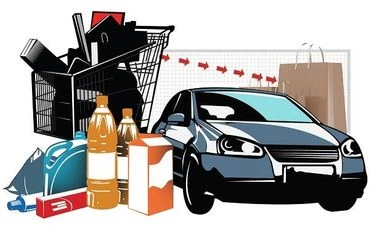The profitability of consumer goods companies has tailed off owing to a rally in commodity prices and lower or slower than expected recovery in demand from the Covid-19 shock last financial year.
The combined profit share of companies in sectors such as auto, fast-moving consumer goods (FMCG), consumer durables, fashion, and quick-service restaurants declined to a 10-year low of 7.7 per cent (among the companies under review) in the first half of FY22 against a pre-pandemic high of 15.4 per cent in H2FY18.
The analysis is based on the half-yearly numbers of 4,166 listed companies, of which 239 fall in the consumer goods and services space.
The combined net profits of the consumer goods companies were up 50 per cent year-on-year (YoY) in H1FY22 to Rs 31,659 crore from Rs 21,000 crore in H1FY21.
The overall corporate net profits more than doubled during the period from around Rs 2 trillion in H1FY21 to Rs 4.09 trillion in H1FY22.
However, sequentially, the consumer companies’ net profits were down 26 per cent in H1FY22 over H2FY21 against a 2.6 per cent decline in overall corporate earnings. (See the adjoining chart.)
Analysts attribute this to margin pressure and lower than expected sales growth.
“The consumer goods companies have not been able to pass on the rise in input costs to consumers, resulting in a margin contraction for most manufacturers. Pricing power for most companies remains weak due to a slow recovery in demand from the Covid-19 shock,” said Dhananjay Sinha, managing director and chief strategist, JM Financial Institutional Equity.
The core operating margins (excluding other income) of the consumer companies in the Business Standard sample were down nearly 180 basis points in H1FY22 over H2FY21, though they were up 30 basis points on a YoY basis. At 13.6 per cent of net sales, the industry’s core operating margins in the first half of FY22 were the lowest since the second half of FY15, with the exception of lockdown-hit H1FY21, when they had declined to 13.3 per cent.
One basis point is one-hundredth of 1 per cent.
Weak consumer demand shows in the sales of the companies. The consumer goods companies accounted for just 7 per cent of the combined net sales of all the listed companies in the analysis in H1FY22, down from 7.1 per cent in H1FY21 and 7.7 per cent in H2FY21. At its peak, the consumer goods companies had an 8 per cent share in overall net sales during the six months ended September 2017.
However, the combined net sales of the consumer goods companies were up 31 per cent YoY in H1FY22 to reach Rs 3.6 trillion from Rs 2.75 trillion in H1FY21. The sector revenues were, however, down 7 per cent sequentially (over H2FY21) and just a notch above the pre-pandemic high of Rs 3.56 trillion in H2FY19.
Among individual sub-segments of the consumer market, the biggest hit has been taken by the automakers, especially the two-wheeler companies, and consumer durables and home appliance makers. In contrast, FMCG companies such as Hindustan Unilever, ITC, Asian Paints, Nestle, Britannia, and Pidilite Industries have shown better pricing power and managed to hold on to their revenue share.
The combined net profits of the automakers nearly doubled in H1FY22 from a record low in H1FY21 but were down 38 per cent sequentially. At Rs 8,054 crore, the automakers’ net profits in H1FY22 were the lowest for the industry in five and a half years with the exception of H1FY21. As a result, the automakers’ share in overall corporate profits declined to 1.97 per cent – the lowest since at least FY10.
The automakers also lagged in revenue growth -- up 29.8 per cent YoY in H1FY22 -- and their share in overall net sales declined to 2.38 per cent, the lowest in six and a half years, with the exception of H1FY21. The auto sector numbers exclude those of non-consumer product makers such as Tata Motors, Ashok Leyland, and Escorts. Makers of consumer durables such as Havells, Bajaj Electricals, Voltas, and Blue Star also showed a similar trend and reported a sharp 41 per cent decline in their earnings in H1FY22 over H2FY21.
In comparison, the combined earnings of the FMCG companies in the sample were up 14 per cent YoY in the first half and were down only 12 per cent sequentially.
At Rs 20,738 crore, the FMCG companies’ combined net profits in H1FY22 were the best after the record high earnings in H2FY21.
Many analysts expect margin expansion for consumer goods makers, especially FMCG companies, on the back of price hikes and moderation in commodity prices.
“Companies have taken price hikes to offset nearly 75 per cent of the cost inflation but have been careful not to disturb reviving demand,” write analysts at Edelweiss Securities.
Unlock 30+ premium stories daily hand-picked by our editors, across devices on browser and app.
Pick your 5 favourite companies, get a daily email with all news updates on them.
Full access to our intuitive epaper - clip, save, share articles from any device; newspaper archives from 2006.
Preferential invites to Business Standard events.
Curated newsletters on markets, personal finance, policy & politics, start-ups, technology, and more.
)